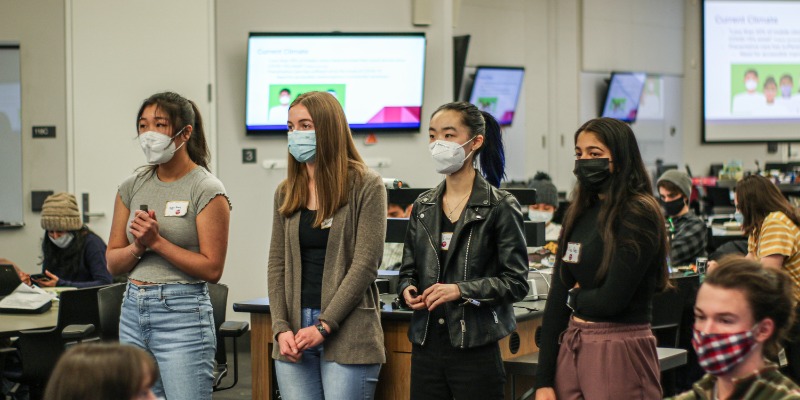The first annual CBS Case Study allowed teams of students to work collaboratively to tackle health and environmental issues.

Saturday mornings on a college campus are typically quiet. On a Saturday in late January though, a different scene unfolded. Dozens of students gathered to research, collaborate and present in Bruininks Hall for the first annual CBS Case Study Competition.
The event aimed to foster social responsibility, problem solving, and communication by providing an opportunity to tackle real-life issues. Aryn Lipnicki, Assistant Director for Student Engagement and the event organizer noted that the event fits in well with priorities of CBS Student Services. “We’re always looking for opportunities to engage students in conversations and experiences that explore the intersections of the life sciences, leadership and community connections,” says Lipnicki.
The inspiration for the event traces back to when Lipnicki attended a research talk by Dean Valery Forbes during which she discussed ecotoxicology research in Manila Bay, a natural harbor in the Philippines. Forbes detailed how the research team took a solely science based approach to the problem, which led to a proposed solution that wasn't actually feasible or accessible to the community.
“Attending this talk sparked an idea to start the case study competition to encourage students to think about science within its real-world context,” says Lipnicki.
Students, mostly from CBS, organized themselves into teams. Teams then selected from one of two case studies — one case study centered on health inequities and the other on an environmental challenge. Teams researched the topic, developed a solution and pitched their plan to a panel of judges all in a few short hours.
Through their collaboration, students learned more than just information about the issues presented to them. Teams gained experience with abstract reasoning and combining social, biological and economic perspectives.
“My main takeaway was that sometimes there is no good answer to a problem, but a bad answer can be better than no answer,” student participant Shoshana Altman said. “Many of the science classes on campus require students to find a specific correct answer, however the complications of life frequently prevent such simplicity outside of the classroom.”
Peek into case studies
One case study focused on health disparities. Specifically, it asked teams to study the disparities in the breast cancer mortality rate of Black women in Chicago. The scenario required teams to assess factors that influence the different outcomes based on race. Teams addressed causes like social determinants of health, genetics, and medical bias, while presenting solutions like mobile screening clinics and health literacy resources.
The other case study examined the impacts of the Three Gorges Dam on the Yangtze River in China. Teams were asked to examine the costs and benefits of the dam to determine whether or not remaining projects for large hydroelectric dams in China should move forward with construction. Teams dove into the human/community, economic, and environmental impacts to asess impacts of dam construction.
Teams collaborated on their research and problem solving throughout the day, enjoyed a catered lunch, and shared their proposed solutions in the afternoon. After much deliberation between judges, winners for each category were announced.
In the health disparities case study, Team 3 with members Sarah Copeland, Fazila Mohamed and Subhika Rao took the prize. This team proposed a multi-pronged solution to addressing breast cancer mortality differences in Chicago through improved diagnostic access, ensuring access to healthy food, and a focus on community education. Judges particularly appreciated some of the more unique aspects of the proposal such as utilizing community gardens to improve healthy food access.
In the environmental case study, members Shoshana Altman, Brett Ruiter and Katie LeGare (who met in Foundations II as first year students) of Group 4 won. Group 4 proposed that no additional dams be constructed due to the negative impacts they have on the local community and environments. And encouraged that funds instead be used to build flood-resistant, pursue other alternative energy options, and promote ecotourism to the region. This group also impressed judges by presenting a plan B of what should happen if additional dams are built such as additional financial support for displaced people, conservations and habitat restoration efforts, and international accountability.
Although this was the first CBS Case Study Competition, it will not be the last. Coordinators of the event plan for it to be an annual event. With a successful first competition under their belts, they plan to continue the CBS Case Study Competition for years to come. —Jacob Loosen